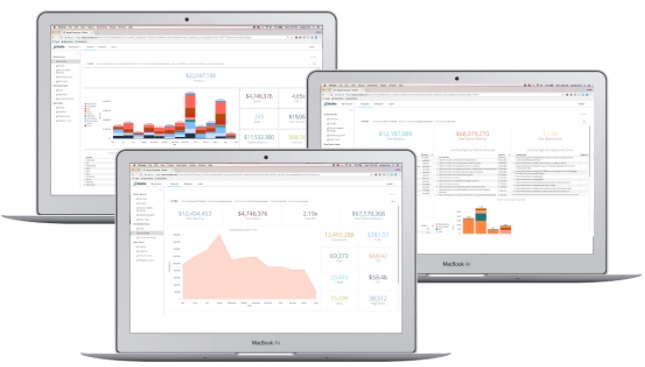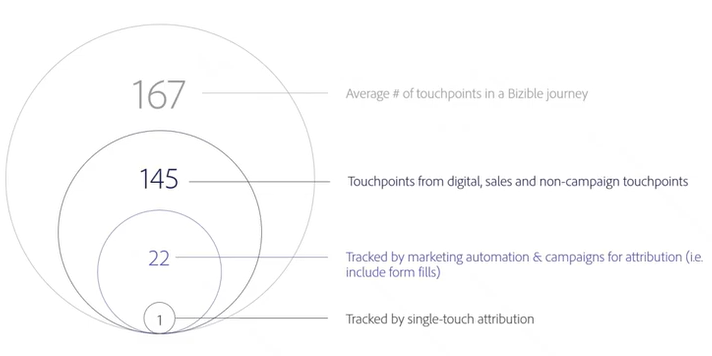
Do you know which marketing programs and channels are driving the most engagement with your prospects and customers? Unless you’re already using a multi-touch attribution tool, this can be hard to do — especially if your organization has a more complex sales cycle.
That’s because many marketers still rely on a CRM like Salesforce, which only provides a first touch or last touch model, or a business intelligence tool, such as PowerBI or Domo. Some even manually pull all of their data from multiple sources and tools into an Excel spreadsheet.
In addition to being manual and incredibly time-consuming, you’re still likely only getting data from the digital engagements you’re currently able to track. What about everything else that marketing and sales does to guide prospects along the buyer’s journey?
And, if you can’t determine which marketing activities are working and which aren’t giving you the ROI you need to justify continued investment, how can you ever be sure you’re spending your precious time on the right things?
What is Marketo Measure (formerly Bizible) and what does a multi-touch attribution tool do?
Marketo Measure (formerly Bizible) is a multi-touch attribution tool that provides the ability to track both online and offline marketing engagements within a single tool.
You read that correctly. Both online and offline, from webinars, events, and sales demos to content syndication, social media campaigns, organic web traffic, and paid media.
Not just first touch or last touch. Every touch.
When trying to determine attribution, the biggest challenge for marketers is how to bring together all of their marketing engagement data in one place. When you can view how all of your marketing content, campaigns, and channels are performing, you can determine which ones are delivering the most pipeline, revenue, and ROI.

Role-based dashboards provide actionable insights for the entire team.
And, no more arguing with sales reps about who gets the credit for that killer lead or new client. Marketo Measure can track every touchpoint your customer has throughout the buyer’s journey. As a result, it demonstrates both marketing’s and sales’ contributions to pipeline and revenue, so everyone gets credit. Because it truly takes a village to guide your prospects from initial awareness to closing the deal.
What are the main benefits?
While helping our clients get up and running on Marketo Measure, I’ve witnessed the benefits first-hand. Below are some of the key benefits of using a multi-touch attribution tool like Marketo Measure:
- Get a full view of all sales and marketing touchpoints within a sales cycle.
- Capture engagement by channel (via UTM parameters for digital channels and CRM campaign costs for offline channels).
- Save time by eliminating manual data consolidation efforts.
- Learn which channels, campaigns, and content deliver the most pipeline, revenue, and ROI at each stage of the demand funnel.
- Demonstrate marketing’s contributions to revenue with highly visual and intuitive dashboards.
Curious about the potential difference between the number of touchpoints your marketing automation platform and CRM system can track versus what Marketo Measure can do?
On an episode of DemandGen TV with BDO Digital Partner and Principal David Lewis, a Marketo Measure product specialist shared just how much variation there can actually be:

Marketo Measure customers have an average of 167 online and offline touchpoints across the buyer’s journey. The illustration above shows the number of touches each tool was able to capture before a prospect became a Marketo Measure customer:
What kind of attribution models are available?
As you can see, there’s a big difference between single-touch and multi-touch attribution. And as esteemed management consultant Peter Drucker pointed out, “If you can’t measure it, you can’t improve it.”
Marketo Measure offers five out-of-the-box attribution models:
- First Touch (FT) Model: 100% attribution is given to the very first interaction a person has with your organization.
- Lead Creation Model: 100% attribution is given to when a contact provides you with their information and becomes a lead or contact in Salesforce (e.g., downloading an eBook).
- U-Shape Model: 50% attribution for First Touch and 50% attribution for Lead Creation.
- W-Shape Model: 30% attribution for First Touch, 30% attribution for Lead Creation, 30% attribution for Opportunity Creation, and 10% attribution for middle touches.
- Full Path Model: 5% attribution for First Touch, 22.5% attribution for Lead Creation, 22.5% attribution for Opportunity Creation, 22.5% attribution for Closed Won, and 10% attribution for middle touches.
The first two models are single-touch attribution models, while the last three are multi-touch attribution models. Lead Creation and Full Path are the most frequently used models because most marketing organizations are primarily focused on lead acquisition through to Closed Won.
For Tier 2 and above Marketo Measure customers, once you’re ready to design your own custom models, you can add more milestones, custom sales funnel stages, and customized attribution percentages to your multi-touch attribution model.
Measure what matters and prove marketing’s impact on revenue
Interested in learning more? As a longtime partner, BDO Digital provides an array of Marketo Measure Services, all the way from starting from scratch with implementation to optimizing your current configuration or attribution model so you can get the most out of your solution. You can learn more by tuning into this webinar, hosted by Adobe and BDO Digital experts. Whether you are ready to take the plunge or need more time to research your options, let us know how we can help!
 Micheline Farah is a Senior Solution Architect, Adobe Marketo Engage in BDO Digital’s Demand Generation Group. She has an extensive marketing technology background, with over 15 years’ experience implementing, optimizing, integrating, and managing marketing automation platforms, including Adobe Marketo Engage and Oracle Eloqua. Micheline has a passion for combining marketing strategy and technology through multi-channel nurturing, scoring, data cleaning, lead management, and system integrations. She helps her clients build highly effective systems for generating successful and repeatable campaigns with a keen focus on marketing attribution reporting.
Micheline Farah is a Senior Solution Architect, Adobe Marketo Engage in BDO Digital’s Demand Generation Group. She has an extensive marketing technology background, with over 15 years’ experience implementing, optimizing, integrating, and managing marketing automation platforms, including Adobe Marketo Engage and Oracle Eloqua. Micheline has a passion for combining marketing strategy and technology through multi-channel nurturing, scoring, data cleaning, lead management, and system integrations. She helps her clients build highly effective systems for generating successful and repeatable campaigns with a keen focus on marketing attribution reporting.
The post If You Can’t Measure It, You Can’t Improve It: A Quick Overview of Bizible’s Multi-Touch Attribution Tool appeared first on DemandGen.





















